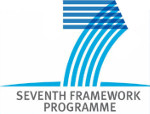Preparation of Drug-Loaded PLGA-PEG Nanoparticles by Membrane-Assisted Nanoprecipitation
Albisa, A. (Universidad de Zaragoza) ; Piacentini, E. ; Sebastian, V. (Universidad de Zaragoza) ; Arruebo, M. (Universidad de Zaragoza) ; Santamaria, J. (Universidad de Zaragoza) ; Giorno, L.
Resumen: Purpose: The aim of this work is to develop a scalable continuous system suitable for the formulation of polymeric nanoparticles using membrane-assisted nanoprecipitation. One of the hurdles to overcome in the use of nanostructured materials as drug delivery vectors is their availability at industrial scale. Innovation in process technology is required to translate laboratory production into mass production while preserving their desired nanoscale characteristics. Methods: Membrane-assisted nanoprecipitation has been used for the production of Poly(D, L lactide-co-glycolide)-co-poly ethylene glycol] diblock) (PLGA-PEG) nanoparticles using a pulsed back-and-forward flow arrangement. Tubular Shirasu porous glass membranes (SPG) with pore diameters of 1 and 0.2 µm were used to control the mixing process during the nanoprecipitation reaction. Results: The size of the resulting PLGA-PEG nanoparticles could be readily tuned in the range from 250 to 400 nm with high homogeneity (PDI lower than 0.2) by controlling the dispersed phase volume/continuous phase volume ratio. Dexamethasone was successfully encapsulated in a continuous process, achieving an encapsulation efficiency and drug loading efficiency of 50% and 5%, respectively. The dexamethasone was released from the nanoparticles following Fickian kinetics. Conclusions: The method allowed to produce polymeric nanoparticles for drug delivery with a high productivity, reproducibility and easy scalability.
Idioma: Inglés
DOI: 10.1007/s11095-017-2146-y
Año: 2017
Publicado en: PHARMACEUTICAL RESEARCH 34, 6 (2017), 1296-1308
ISSN: 0724-8741
Factor impacto JCR: 3.335 (2017)
Categ. JCR: CHEMISTRY, MULTIDISCIPLINARY rank: 61 / 171 = 0.357 (2017) - Q2 - T2
Categ. JCR: PHARMACOLOGY & PHARMACY rank: 74 / 261 = 0.284 (2017) - Q2 - T1
Factor impacto SCIMAGO: 1.077 - Biotechnology (Q1) - Organic Chemistry (Q1) - Pharmaceutical Science (Q1) - Pharmacology (Q2) - Pharmacology (medical) (Q2) - Molecular Medicine (Q2)
Financiación: info:eu-repo/grantAgreement/EC/FP7/321642/EU/Development of a microfluidic platform to produce nanomaterials and assessment on new nanotechnology applications/PLATFORM2NANO
Financiación: info:eu-repo/grantAgreement/EC/FP7/614715/EU/A Photo-triggered On-demand Drug Delivery System for Chronic Pain/NANOHEDONISM
Tipo y forma: Article (PostPrint)
Área (Departamento): Área Ingeniería Química (Dpto. Ing.Quím.Tecnol.Med.Amb.)
Exportado de SIDERAL (2019-07-09-12:00:26)
Visitas y descargas
Idioma: Inglés
DOI: 10.1007/s11095-017-2146-y
Año: 2017
Publicado en: PHARMACEUTICAL RESEARCH 34, 6 (2017), 1296-1308
ISSN: 0724-8741
Factor impacto JCR: 3.335 (2017)
Categ. JCR: CHEMISTRY, MULTIDISCIPLINARY rank: 61 / 171 = 0.357 (2017) - Q2 - T2
Categ. JCR: PHARMACOLOGY & PHARMACY rank: 74 / 261 = 0.284 (2017) - Q2 - T1
Factor impacto SCIMAGO: 1.077 - Biotechnology (Q1) - Organic Chemistry (Q1) - Pharmaceutical Science (Q1) - Pharmacology (Q2) - Pharmacology (medical) (Q2) - Molecular Medicine (Q2)
Financiación: info:eu-repo/grantAgreement/EC/FP7/321642/EU/Development of a microfluidic platform to produce nanomaterials and assessment on new nanotechnology applications/PLATFORM2NANO
Financiación: info:eu-repo/grantAgreement/EC/FP7/614715/EU/A Photo-triggered On-demand Drug Delivery System for Chronic Pain/NANOHEDONISM
Tipo y forma: Article (PostPrint)
Área (Departamento): Área Ingeniería Química (Dpto. Ing.Quím.Tecnol.Med.Amb.)
Exportado de SIDERAL (2019-07-09-12:00:26)
Permalink:
Visitas y descargas
Este artículo se encuentra en las siguientes colecciones:
articulos > articulos-por-area > ingenieria_quimica
Notice créée le 2018-03-26, modifiée le 2019-07-09
